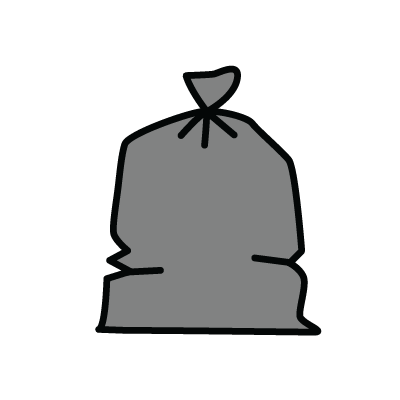
Household waste is waste that can not be separated for reuse or recycling like cigarettes, rubber and cork. Waste types that you can separate, such as organic waste, glass and paper, are not household waste.

How is the waste collected?
Household waste and organic kitchen and garden waste are gathered separately in small bins (the grey bin and the green bin) and then collected from outside family homes at set times.
For people living in apartments
The system is slightly different for people living in apartments: their organic waste is not gathered separately, but is disposed together with their household waste, either in bags or in underground containers. To use the underground containers, you need a Cure milieupas.
Household waste:
- is waste that can not be separated for reuse and recycling
- needs to be put in the grey bin of underground container
- you can check the waste collection schedule to see when the waste will be collected
- put your bin outside before 7.30 o'clock in the morning (at 7.00 o'clock during the months July and August)
- get your bin back in before midnight
Here's how to present your container
It's very helpful to our drivers (and yourself) if you present your waste container properly. Here's what's important:
- Place the container at a maximum of 50 cm away from the pavement border
- Leave at least 30 cm of space between 2 containers or other obstacles (like streetlights or parked cars)
- Place the container with the lid facing the street
- Make sure the lid is closable and closed
- A waste container cannot weigh more than 70 kilos
Frequently asked questions about household waste
Household waste is non-recyclable. It is burned in large ovens. This generates energy (electricity) and heat. The leftover product can be used for example as building materials, like road foundations.
Residents of low-rise houses/apartments (single-family homes) have their own grey container (kliko). This is at the house and is emptied every two weeks. Residents of high-rise buildings (flats and appartments) have an underground container available for household waste near their building. You open this with your Cure environmental card (Eindhoven), your municipal card (Geldrop-Mierlo) or your environmental card (Valkenswaard).
Yes, GFT (vegetable, fruit and garden waste) can go in the household waste container. You can also put it in an underground container to minimalise odors.
If you've been appointed an underground container, you can open this with your Cure environmental card, municipal card or environmental card.
It can be an inconvenience when your container hasn't been fully emptied.
Check the contents to see if there is any blockage in the container. If the container is packed too tight, that can also be the reason the contents didn't fully come out.
In these cases, we request you remove the blockage. Then, you place the container by the street as usual on the next emptying date.
What qualifies as household waste?
Yes
- Cat litter
- Feces of dogs and cats
- Diapers (in Geldrop-Mierlo, these must go in the diaper containers)
- Cigarettes and ash
- Sanitary towels
- Rubber
- Cork
- Electrical wiring
No
Everything that is collected separately like:
- Paper
- Glass
- PBD (Plastic, Tin cans & Drink cartons)
- Textiles
- Construction and demolition waste
- Organic waste (except households that use underground containers)
When to present your waste
Eindhoven & Geldrop - Mierlo: Only present your waste on collection days, before 7:30 AM. In the summer months of July and August, present the waste before 7:00 AM. Bring your container back inside before midnight on the collection day.
Valkenswaard: Only present your waste on collection days, before 7:30 AM. Bring your container back inside before midnight on the collection day.
Tip!
"Put household waste in sealed bags before depositing it in the (underground) container to avoid unpleasant smells and to keep the container clean."






